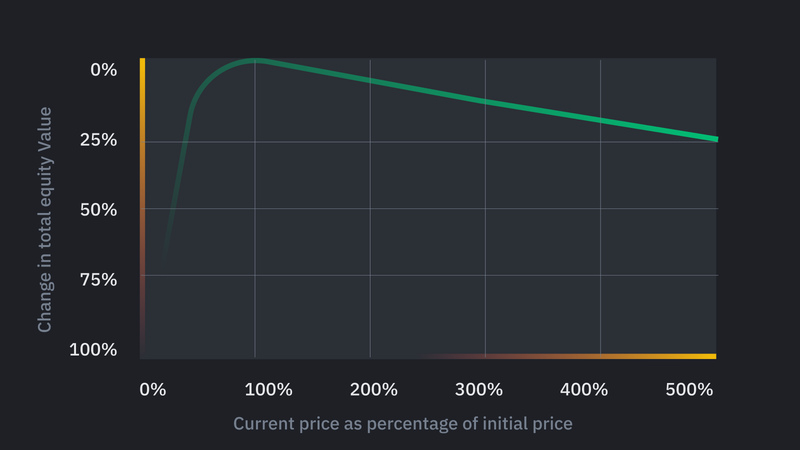What Is Impermanent Loss And How To Avoid It?

Investors familiar with decentralized finance (DeFi) surely must know about one common risk – impermanent loss. It’s a phenomenon that occurs when a liquidity provider (LP) provides assets to a liquidity pool on a decentralized exchange (DEX). If the token prices change or fluctuate, the LPs could lose money.
Therefore, it’s essential to understand how impermanent loss happens so that traders and LPs can make informed decisions when participating in liquidity pools.
Our guide fully explains how an impermanent loss occurs, how to calculate it, and how to avoid it using simple English – no technical jargon.
Impermanent Loss Summary
The key point from our guide:
- Impermanent loss is a common risk in decentralized exchanges.
- It occurs when the price of one asset changes relative to the other token.
- The AMM algorithm must maintain the same ratio by adjusting the prices of tokens.
- If the price of one asset fluctuates, the value of the LP’s share can also vary.
- LPs can reduce impermanent loss risks by following the strategies we listed below.
What Is Impermanent Loss And How Does It Occur?
Impermanent loss is a common risk in DEXs that use automated market makers (AMMs) like Uniswap, SushiSwap, and PancakeSwap.
When LPs provide assets to a liquidity pool, they essentially supply liquidity to the exchange. In return, they receive a portion of the trading fees that the pool generates. The value of the LP’s share is based on the ratio of assets they provide.
However, because the prices of assets in the pool can fluctuate, the value of the LP’s share can also vary. And this fluctuation is called impermanent loss. It occurs when the price of one asset in a liquidity pool changes relative to the other assets.
LPs provide assets to the pool in a specific ratio, and the AMM algorithm maintains that ratio by adjusting the price of the tokens. As a result, if the price of one asset increases or decreases significantly, the LP’s portfolio will change in value compared to holding the assets outside the pool.
Examples
Let’s take a look at some examples of impermanent loss to better understand how it works.
ETH/USDT Trading Pair
Suppose an LP provides 1 ETH and 10,000 USDT to a liquidity pool with an ETH/USDT trading pair. At the time of trading, 1 ETH was worth $2,000, and 10,000 USDT was worth $10,000. Then, the ETH price increased to $3,000, while USDT remained stable at $1. As a result, the LP’s share of the pool would be worth 0.0492 ETH less than if they had held the assets outside the pool.
BTC/USDT Trading Pair
An LP provides 1 BTC and 10,000 USDT to a liquidity pool with a BTC/USDT trading pair. At that time, 1 BTC was worth $60,000, and 10,000 USDT was worth $10,000. After some time, the price of BTC dropped to $50,000, while USDT remained stable at $1. Therefore, the LP’s pool share would be worth 0.155 BTC less than if they had held the assets outside the pool.
USDC/DAI Trading Pair
Let’s say an LP provides 10,000 USDC and 10,000 DAI to a liquidity pool with a USDC/DAI trading pair. USDC and DAI were worth $1 each at the time of trading. However, the price of USDC increased to $1.10, while DAI decreased to $0.90. Accordingly, the LP’s pool share would be worth 2.2% less than if they had held the assets outside the pool.

Can You Avoid Impermanent Loss?
Although it’s impossible to avoid impermanent loss altogether, there are some strategies that traders and liquidity providers can use to minimize its impact. That includes:
- Choosing trading pairs with lower volatility: High volatility can lead to significant price swings in the assets in a pool, which can exacerbate IL. Therefore, selecting trading pairs with lower volatility is better to reduce the risk of significant losses.
- Considering providing liquidity to stablecoin pairs: Stablecoins like USDT or DAI are less prone to price fluctuations than other cryptocurrencies.
- Monitoring your LP position regularly: Impermanent loss is not permanent and can be offset by the trading fees earned by the pool. LPs can monitor their position and wait for the exchange to earn trading fees to counteract IL before withdrawing their assets.
- Using impermanent loss protection protocols: Some DeFi protocols offer impermanent loss protection by hedging LP positions with options or other financial instruments. These protocols can help LPs protect against IL, but they typically charge a fee for this service.
- Diversifying your LP positions: Holding LP positions in multiple pools can help spread the risk of impermanent loss across different assets and trading pairs. This strategy can help reduce the impact of IL on the overall LP portfolio.
Please note that providing liquidity to DEX pools carries inherent risks, including impermanent loss. LPs should carefully consider them before participating in liquidity pools and only invest what they can afford to lose.
FAQ
Everything you need to know and more.
What is impermanent loss?
Impermanent loss is a temporary loss of value that liquidity providers (LPs) can experience when providing liquidity to DEX pools. It occurs when the value of assets in the pool changes relative to their value outside the pool, resulting in a loss for LPs.
Can you avoid impermanent loss?
You cannot completely avoid impermanent loss, but LPs can use strategies like choosing trading pairs with lower volatility, providing liquidity to stablecoin pairs, monitoring their LP position regularly, using impermanent loss protection protocols, and diversifying their LP positions to minimize its impact.
What are the risks of IL?
The main risk of impermanent loss is a temporary loss of value for LPs. However, you can counter it with the trading fees earned by the pool. LPs should carefully consider these risks before participating in liquidity pools and only invest what they can afford to lose.
How to calculate impermanent loss?
Calculate impermanent loss by comparing the value of an LP’s pool share when providing liquidity to its current value. This calculation considers the price changes of the assets in the pool and the LP’s share of the pool.
Can you recover from impermanent loss?
Impermanent loss is not permanent. LPs can counter it with the trading fees earned by the pool. LPs can monitor their position regularly and wait for the pool to earn trading fees to offset impermanent loss before withdrawing their assets.
Final Words
Traders and liquidity providers must be aware when providing liquidity to DEX pools. By understanding how impermanent loss occurs and using strategies to mitigate its impact, they can potentially reduce their risk of loss and make informed decisions when participating in liquidity pools.
Crypto trading (trading in general, actually) is always a risky business because the industry is volatile. Therefore, make smart choices and don’t invest more than you can afford to lose.





